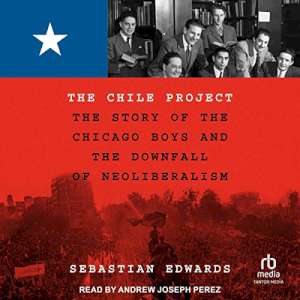21 March 2024
The Chile Project
The Story of the Chicago Boys and the Downfall of Neoliberalism
Sebastian Edwards
2023, Princetown University Press, 376 pages,
ISBN 9780691208626
Reviewer: Maximilian Magnacca

Sebastian Edwards has taken on the formidable challenge of writing an economic and policy history of the famous (or infamous) Chicago Boys and their influence in Chile from before the Pinochet regime up to the modern day. Edwards is well-placed to write this history given his Chilean heritage, his experience living and working in Chile during this time, and having known, and worked with some of the main characters of the group known as the Chicago Boys. In my opinion, he has been able to write an interesting, even-handed, and thorough book on the Chicago Boys providing an up-to-date history in the English language.
To preface, the original Chicago Boys were a group of Chilean students that were selected to attend the University of Chicago on an exchange in order to gain educational training in modern economics and improve the academic economic community in Chile. This, however, was during the Cold War so constituted an attempt by the United States to bring Chile and Chilean economic thinking and policy in line with the United States rather than the USSR. Given this background, the Chicago Boys quickly became a shorthand for neoliberal policies i.e., free markets, deregulation, and minimal state intervention.
The book is accessible for both technical and non-technical audiences, reading more like a popular history that can be read cover-to-cover and is organized chronologically. This was a deliberate choice by the author in order to contextualise the original Chicago Boys within Chile in the 1950s and to track their influence since then to help make sense of the Chile of today.
It is this contextualisation that is particularly interesting as many of the policies undertaken and subsequent outcomes in Chile do not look out of place in a modern economy such as free trade, an independent central bank, prices being predominantly determined by competition in the open market, and market incentives being widely used. Yet, these policies were considered radical at the time of first proposal and implementation in 1970s Chile even by those who would supposedly benefit, such as private businesses. Edwards makes the argument that ultimately it is due to these policies that Chile, with all its faults and evident social inequality, is amongst the most developed Latin American countries and even though at various points in time, it has been said that the Chicago Boys’ policies will be reversed under democracy that they have yet to be fundamentally unwounded even after the 2019 protests.
However, the author does make the point that the 2019 protests have called time on the neoliberal model even though it is uncertain what the new institutional model Chile will adopt. This stems, according to the author, from the lack of importance placed on distributional inequality as well as other social and environmental issues by the Chicago Boys, who were more focused on absolute poverty and had a belief in the effectiveness of the free market to deal with social ills, which ultimately led to social unrest. This is a timely addition to the wider inequality literature as more and more countries grapple with the question of what should be prioritised (economic growth, inequality, absolute poverty reduction) and what are the correct policies for dealing with these challenges.
Also, Edwards is able to convincingly demonstrate that the Chicago Boys were not one homogenous group of people, all intimately tied to the Pinochet regime, and extreme free-market supporters. In fact, he shows that not only was it not certain that the Chicago Boys and their policies would be adopted either partially or in full by the Pinochet regime due to opposition from certain factions of the military, but that there could be huge opposition and debate of what policy direction should be taken even within the Chicago Boys group. This could be seen in discussions around what to do about inflation in the 1970s, or what was the most appropriate foreign exchange policy in the early 1980s. It can also be seen in the moment when Pinochet decided to pivot away from the Chicago Boys and their reforms in 1984, though he ultimately returned to their reforms in 1985.
Readers should be aware that there is little discussion of the wider political, humanitarian, and social issues that occurred under the Pinochet regime when not involving the Chicago Boys directly. This being said, the book does discuss to what extent is it credible to believe the Chicago Boys were completely unaware of the actions of the regime and the book doesn’t shy away from discussing the actions where relevant. However, it does not spend a significant amount of time on these issues.
Ultimately, Edwards has provided a comprehensive book on a complicated period of Chilean economic history. I recommend it to any interested in Chile, economic history in a broad sense, and for those who are looking for an unbiased view of the Chicago Boys and their influence.
